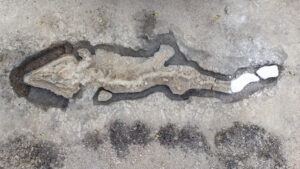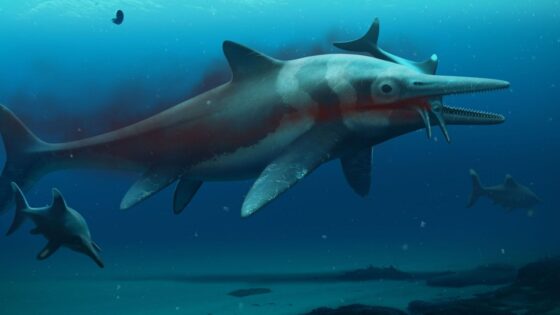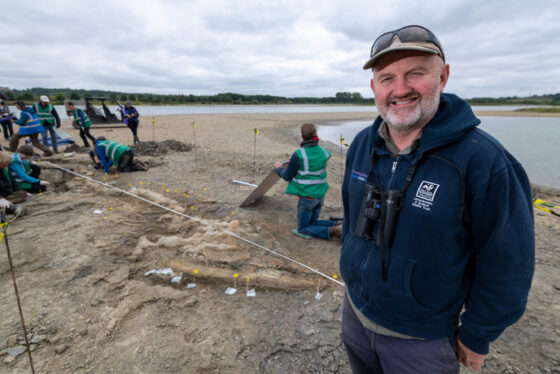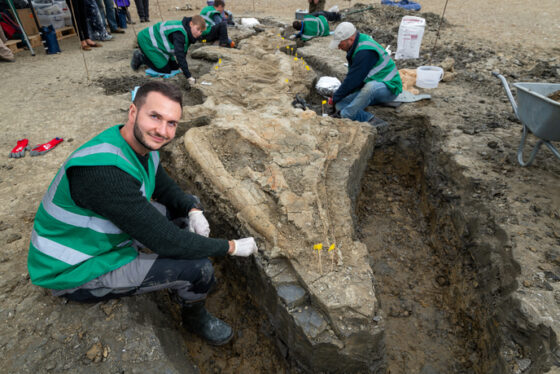
Britain’s largest ‘Sea Dragon’ discovered in UK’s smallest county

The fossilised remains of Britain’s largest ichthyosaur, known as a ‘Sea Dragon’, has been discovered at Rutland Water Nature Reserve. The ichthyosaur was discovered by Joe Davis, Rutland Water Conservation team leader, during the routine draining of a lagoon island for re-landscaping in February 2021.
To date, it is the largest and most complete skeleton of its kind found in the UK and is also thought to be the first ichthyosaur of its species (called Temnodontosaurus trigonodon) found in the country.
Davis and reserves officer Paul Trevor set off across the lagoon when Joe noticed what looked like clay pipes sticking up out of the mud, except that “they looked organic.”

Image courtesy of Bob Nicholls Artwork
Davis says: “I worked out on the Hebrides, so I’ve found whale and dolphin skeletons before. This appeared similar and I remarked to Paul that they looked like vertebrae. We followed what indisputably looked like a spine and Paul discovered something further along that could have been a jawbone. We couldn’t quite believe it.
“The find has been absolutely fascinating and a real career highlight, it’s great to learn so much from the discovery and to think that this amazing creature was once swimming in seas above us, and now once again Rutland Water is a haven for wetland wildlife albeit on a smaller scale!”
The ichthyosaur is approximately 180 million years old and, with a skeleton measuring around 10 metres in length and a skull weighing approximately one tonne, it is the most complete large ichthyosaur ever found in Britain.
 Dr Dean Lomax being used for scale
Dr Dean Lomax being used for scale
Images courtesy of Matthew Power Photography
Ichthyosaurs first appeared around 250 million years ago and went extinct 90 million years ago. They were an extraordinary group of marine reptiles that varied in size from 1 to more than 25 metres in length, and resembled dolphins in general body shape.
The fragile remains of the huge skeleton were carefully excavated in August and September 2021 by a team of expert palaeontologists assembled from around the UK, in partnership with Anglian Water, Rutland County Council and Leicestershire and Rutland Wildlife Trust. The excavation was led by world ichthyosaur expert Dr Dean Lomax and specialist palaeontological conservator Nigel Larkin, along with marine reptile specialist Dr Mark Evans, Dr Emma Nicholls from the Horniman Museum and volunteers with experience of excavating fossilised marine reptiles.
The remains were fully excavated early last year and will feature on BBC Two’s Digging for Britain, on Tuesday 11th January at 8pm.
At over ten metres long, this is the biggest and most complete skeleton of its kind found to date in the UK. The discovery is not the first at the Anglian Water reservoir, with two incomplete and much smaller ichthyosaurs found during the initial construction of Rutland Water in the 1970s. It is however the first complete skeleton to be discovered there.
CEO for Anglian Water, Peter Simpson says: “Rutland Water has a long list of previous, fascinating archaeological and palaeontological discoveries, but none more exciting than this. We also recognise the significance a find like this will have for the local community in Rutland. Our focus now is to secure the right funding to guarantee its legacy will last into the future.”

In order to preserve the precious remains, Anglian Water is seeking heritage funding. This will also ensure that it can remain in Rutland where its legacy can be shared with the general public.
Dr Dean Lomax, who has studied thousands of ichthyosaurs and named five new species in the process, says: “It was an honour to lead the excavation. Britain is the birthplace of ichthyosaurs – their fossils have been unearthed here for over 200 years, with the first scientific dating back to Mary Anning and her discoveries along the Jurassic Coast. Despite the many ichthyosaur fossils found in Britain, it is remarkable to think that the Rutland ichthyosaur is the largest skeleton ever found in the UK. It is a truly unprecedented discovery and one of the greatest finds in British palaeontological history.”
Dr Mark Evans of the British Antarctic Survey and a visiting fellow at the University of Leicester says: “I’ve been studying the Jurassic fossil reptiles of Rutland and Leicestershire for over twenty years. When I first saw the initial exposure of the specimen with Joe Davis I could tell that it was the largest ichthyosaur known from either county.
“However, it was only after our exploratory dig that we realised that it was practically complete to the tip of the tail. Rutland’s motto, ‘Multum in Parvo’, translates as ‘Much in Little’ so it is fitting that we’ve found Britain’s largest ichthyosaur skeleton in England’s smallest county. It’s a highly significant discovery both nationally and internationally but also of huge importance to the people of Rutland and the surrounding area.”
The team of palaeontologists will continue to work on the research and conservation of this significant scientific discovery, with academic papers to be published in the future.
